| This article needs additional citations for verification. Please help improve this article by adding citations to reliable sources. Unsourced material may be challenged and removed. Find sources: "Patriarchal cross" – news · newspapers · books · scholar · JSTOR (September 2014) (Learn how and when to remove this message) |
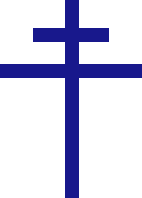
The Patriarchal cross is a variant of the Christian cross, the religious symbol of Christianity, and is also known as the Cross of Lorraine. Similar to the Latin cross, the patriarchal cross possesses a smaller crossbar placed above the main one so that both crossbars are near the top. Sometimes the patriarchal cross has a short, slanted crosspiece near its foot (Russian Orthodox cross). This slanted, lower crosspiece often appears in Byzantine Greek and Eastern European iconography, as well as in other Eastern Orthodox churches. In most renditions of the Cross of Lorraine, the horizontal bars are "graded" with the upper bar being the shorter, though variations with the bars of equal length are also seen.
Imagery
The top beam represents the plaque bearing the inscription "Jesus the Nazarene, King of the Jews" (often abbreviated in the Latinate "INRI" and in the Greek as "INBI").
Many symbolic interpretations of the double-cross have been put forth. One of them says that the first horizontal line symbolized the secular power and the other horizontal line the ecclesiastic power of Byzantine emperors, and also that the first cross bar represents the death, and the second cross the resurrection, of Jesus Christ.
Other variations
The Russian Orthodox cross can be considered a modified version of the Patriarchal cross, having two smaller crossbeams, one at the top and one near the bottom, in addition to the longer crossbeam. One suggestion is the lower crossbeam represents the footrest (suppedaneum) to which the feet of Jesus were nailed. However, there is no evidence of footrests ever being used during the crucifixion, and it has a deeper meaning. The bottom beam may represent a balance of justice. Some sources suggest that as one of the thieves being crucified with Jesus repented of his sin and believed in Jesus as the Messiah and was thus with Christ in Paradise, the other thief rejected and mocked Jesus and therefore descended into Hades. In some earlier representations (and still currently in the Greek Church) the crossbar near the bottom is straight or slanted upwards. In later Slavic and other traditions, it came to be depicted as slanted, with the side to the viewer's left usually being higher.
One tradition says that this comes from the idea that as Jesus Christ took his last breath, the bar to which his feet were nailed broke, thus slanting to the side. Another tradition holds that the slanted bar represents the repentant thief and the unrepentant thief that were crucified with Christ, the one to Jesus' right-hand repenting and rising to be with God in Paradise, and one on his left falling to Hades and separation from God. In this manner, it also reminds the viewer of the Last Judgment. Still another explanation of the slanted crossbar would suggest the Cross Saltire, as tradition holds that the Apostle St. Andrew introduced Christianity to lands north and west of the Black Sea: today's Ukraine, Russia, Belarus, Moldova, and Romania.
-
 Roman Catholic metropolitan archbishop's coat of arms (version with pallium
Roman Catholic metropolitan archbishop's coat of arms (version with pallium
-
 The Russian cross, with slanted cross-bar (suppedaneum)
The Russian cross, with slanted cross-bar (suppedaneum)
-
 A variation of the Russian cross, so called "Calvary cross"
A variation of the Russian cross, so called "Calvary cross"
-
 Archangels' cross
Archangels' cross
-
 Archangels' cross variant
Archangels' cross variant
Byzantine Empire
The Patriarchal cross first regularly appeared on the coinage of the Byzantine Empire starting with the second reign of the Emperor Justinian II, whose second reign was from 705–711. At the beginning of the second reign, the Emperor was depicted on the solidus holding a globus cruciger with a Patriarchal cross at the top of the globe. Until then, the standard practice was to show the globus cruciger with an ordinary cross. The Emperor Theodosius III, who ruled from 715 to 717, made the Patriarchal cross a standard feature of the gold, silver and bronze coinage minted in Constantinople. After his short reign ended, the practice was discontinued under his successor, Leo III, due to his iconoclastic views, and was not revived again until the middle of the eighth century by Artavasdus.
-
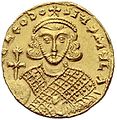 A solidus of Emperor Theodosius III (r. 715–717) holding a globus cruciger surmounted by a patriarchal cross.
A solidus of Emperor Theodosius III (r. 715–717) holding a globus cruciger surmounted by a patriarchal cross.
-
 A histamenon of co-Emperors Nikephoros II (r. 963–969) and Basil II (r. 976–1025) depicted "wielding the sceptre" (patriarchal cross).
A histamenon of co-Emperors Nikephoros II (r. 963–969) and Basil II (r. 976–1025) depicted "wielding the sceptre" (patriarchal cross).
-
 A miliaresion of Emperor Michael VII Doukas (r. 1071–1078) depicting a middle Byzantine cross-crosslet variant of the patriarchal cross.
A miliaresion of Emperor Michael VII Doukas (r. 1071–1078) depicting a middle Byzantine cross-crosslet variant of the patriarchal cross.
-
 A fresco of Serbian Emperor Stefan Dušan holding the patriarchal cross in the manner of a Byzantine Emperor.
A fresco of Serbian Emperor Stefan Dušan holding the patriarchal cross in the manner of a Byzantine Emperor.
Hungary
The two-barred cross has been one of the main elements in the coat of arms of Hungary at least since 1190. It appeared during the reign of King Béla III, who was raised in the Byzantine court. He was for a time heir to the throne of the Byzantine Empire and betrothed to the emperor's daughter. When the emperor's wife gave birth to a son, the emperor dissolved his daughter's betrothal to Béla and removed Béla's title of despotes. Soon after Béla left Constantinople when he inherited the Hungarian throne in 1172. The cross started appearing floating in the coat of arms and on the coins from this era. During the middle ages, the two-barred cross became associated with the Árpád dynasty and the Kingdom of Hungary along with the Árpád stripes. Even the orb of Hungary has a two-barred cross instead of a simple cross. The symbol found its way to Western Europe through Hungary, because René the Good, who was related to the House Anjou of Hungary, laid claim to four kingdoms, including Hungary. He placed the symbol on his flags before the battle of Nancy. He won the battle and regained his lost Duchy of Lorraine. Thus the symbol became known in Western-Europe as the Cross of Lorraine.
-
 Saint Stephen, the first King of Hungary (1000–1038).
Saint Stephen, the first King of Hungary (1000–1038).
-
 Coat of arms of Hungary under king Béla III
Coat of arms of Hungary under king Béla III
-
 The seal of King Béla IV of Hungary (1235–1270) from his Golden Bull
The seal of King Béla IV of Hungary (1235–1270) from his Golden Bull
-
 Hungarian flag from Königsfelden Monastery from the first half of the 14th century, from the monastery of Agnes of Habsburg, widow of King Andrew III of Hungary (1290–1301)
Hungarian flag from Königsfelden Monastery from the first half of the 14th century, from the monastery of Agnes of Habsburg, widow of King Andrew III of Hungary (1290–1301)
-
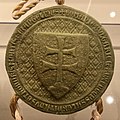 Reverse of the second double seal (1366–1382) of King Louis I the Great (1342–1382). This was later become the predecessor to the modern coat of arms of Slovakia.
Reverse of the second double seal (1366–1382) of King Louis I the Great (1342–1382). This was later become the predecessor to the modern coat of arms of Slovakia.
-
 Reverse of the first double seal (1387–1405) of King Sigismund of Luxembourg (1387–1437)
Reverse of the first double seal (1387–1405) of King Sigismund of Luxembourg (1387–1437)
-
 Coat of arms of Hungary
Coat of arms of Hungary
-
 Archangel Gabriel holds the Holy Crown and the apostolic double cross as the symbols of Hungary, Hősök tere, Budapest, Hungary
Archangel Gabriel holds the Holy Crown and the apostolic double cross as the symbols of Hungary, Hősök tere, Budapest, Hungary
-
The real Holy Crown of Hungary, with the orb, sword of state and sceptre, on display at the Hungarian Parliament Building in Budapest; note the apostolic double cross on the orb
Lithuania and Belarus
Another form of the cross was used by the Jagiellonian dynasty. This cross now features on the coat of arms of Lithuania, where it appears on the shield of the Vytis. It is also the badge of the Lithuanian Air Force and forms the country's highest award for bravery, the Order of the Cross of Vytis. The Jagiellonian cross is also used on the coat of arms and flags of every Lithuanian county, yet not following any heraldic rules.
The Patriarchal Cross appears on the Pahonia, used at various times as the coat of arms of Grand Duchy of Lithuania for centuries and of Belarus.
-
 Coat of arms of King Władysław II Jagiełło
Coat of arms of King Władysław II Jagiełło
-
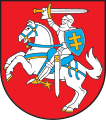 The coat of arms of Lithuania, with the patriarchal cross on the knight's shield
The coat of arms of Lithuania, with the patriarchal cross on the knight's shield
-
 Pahonia used at various times as the coat of arms of Belarus, preserving the original name and appearance since the times of Grand Duchy of Lithuania.
Pahonia used at various times as the coat of arms of Belarus, preserving the original name and appearance since the times of Grand Duchy of Lithuania.
-
 The badge of the Lithuanian Air Force
The badge of the Lithuanian Air Force
Russia
During 1577–1625 the Russian use of the cross was between the heads of the double-headed eagle in the coat of arms of Russia.
Slovakia
The territory of present-day Slovakia was an integral part of the Kingdom of Hungary from the 10th century until the Treaty of Trianon in 1920. Many of its cities gained privileges and coats of arms from the Hungarian kings, often containing the kings' own coat of arms.
First Slovak Republic (1939–1945)
-
 Coat of arms of First Slovak Republic
Coat of arms of First Slovak Republic
-
 War flag of the First Slovak Republic, used by a country's military forces
War flag of the First Slovak Republic, used by a country's military forces
-
 Presidential standard of First Slovak Republic
Presidential standard of First Slovak Republic
-
 Emblem of the Hlinka's Slovak People's Party
Emblem of the Hlinka's Slovak People's Party
-
 Flag of the Hlinka's Slovak People's Party
Flag of the Hlinka's Slovak People's Party
Slovak Republic (since 1993)
-
 Coat of arms of Slovakia
Coat of arms of Slovakia
-
 Flag of Slovakia
Flag of Slovakia
-
 Presidential standard of Slovakia
Presidential standard of Slovakia
-
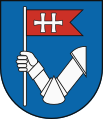 Coat of arms of the city of Nitra, Slovakia
Coat of arms of the city of Nitra, Slovakia
-
 Coat of arms of Nitra Region, Slovakia
Coat of arms of Nitra Region, Slovakia
-
 Coat of arms of the city of Žilina, Slovakia
Coat of arms of the city of Žilina, Slovakia
-
 Coat of arms of Žilina Region, Slovakia
Coat of arms of Žilina Region, Slovakia
-
 Coat of arms of the city of Skalica, Slovakia
Coat of arms of the city of Skalica, Slovakia
-
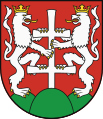 Coat of arms of the city of Levoča, Slovakia
Coat of arms of the city of Levoča, Slovakia
-
 Coat of arms of the city of Zvolen, Slovakia
Coat of arms of the city of Zvolen, Slovakia
Typefaces
Unicode defines the character ☦ (Russian cross) and ☨ (Cross of Lorraine) in the Miscellaneous Symbols range at code point U+2626 and U+2628 respectively.
See also
References
- Breckenridge, James (1959). The Numismatic Iconography of Justinian II. The American Numismatic Society. p. 23.
- Sear, David (1987). Byzantine Coins and Their Values. Seaby. pp. 283–84. ISBN 0900652713.
- Engel 2001, p. 86.
- Monter 2007, pp. 22–23.
Sources
- Engel, Pál (2001). The Realm of St Stephen: A History of Medieval Hungary, 895–1526. I.B. Tauris Publishers. ISBN 1-86064-061-3.
- Monter, William (2007). A Bewitched Duchy: Lorraine and its Dukes, 1477–1736. Librairie Droz. ISBN 978-2-600-01165-5.
